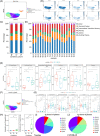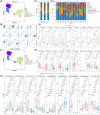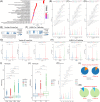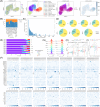Single-cell transcriptomic atlas reveals distinct immunological responses between COVID-19 vaccine and natural SARS-CoV-2 infection
- PMID: 35859327
- PMCID: PMC9350186
- DOI: 10.1002/jmv.28012
Single-cell transcriptomic atlas reveals distinct immunological responses between COVID-19 vaccine and natural SARS-CoV-2 infection
Abstract
To control the ongoing coronavirus disease-2019 (COVID-19) pandemic, CoronaVac (Sinovac), an inactivated vaccine, has been granted emergency use authorization by many countries. However, the underlying mechanisms of the inactivated COVID-19 vaccine-induced immune response remain unclear, and little is known about its features compared to (Severe acute respiratory syndrome coronavirus 2) SARS-CoV-2 infection. Here, we implemented single-cell RNA sequencing (scRNA-seq) to profile longitudinally collected PBMCs (peripheral blood mononuclear cells) in six individuals immunized with CoronaVac and compared these to the profiles of COVID-19 infected patients from a Single Cell Consortium. Both inactivated vaccines and SARS-CoV-2 infection altered the proportion of different immune cell types, caused B cell activation and differentiation, and induced the expression of genes associated with antibody production in the plasma. The inactivated vaccine and SARS-COV-2 infection also caused alterations in peripheral immune activity such as interferon response, inflammatory cytokine expression, innate immune cell apoptosis and migration, effector T cell exhaustion and cytotoxicity, however, the magnitude of change was greater in COVID-19 patients, especially those with severe disease, than in immunized individuals. Further analyses revealed a distinct peripheral immune cell phenotype associated with CoronaVac immunization (HLA class II upregulation and IL21R upregulation in naïve B cells) versus SARS-CoV-2 infection (HLA class II downregulation and IL21R downregulation in naïve B cells from severe disease individuals). There were also differences in the expression of important genes associated with proinflammatory cytokines and thrombosis. In conclusion, this study provides a single-cell atlas of the systemic immune response to CoronaVac immunization and revealed distinct immune responses between inactivated vaccines and SARS-CoV-2 infection.
Keywords: COVID-19; CoronaVac; SARS-CoV-2; immunological responses; inactivated vaccine; single-cell sequencing.
© 2022 Wiley Periodicals LLC.
Conflict of interest statement
The authors declare no conflict of interest.
Figures








Similar articles
-
Immunogenicity and immune-persistence of the CoronaVac or Covilo inactivated COVID-19 Vaccine: a 6-month population-based cohort study.Front Immunol. 2022 Aug 12;13:939311. doi: 10.3389/fimmu.2022.939311. eCollection 2022. Front Immunol. 2022. PMID: 36032136 Free PMC article.
-
Proteomic and Metabolomic Signatures Associated With the Immune Response in Healthy Individuals Immunized With an Inactivated SARS-CoV-2 Vaccine.Front Immunol. 2022 May 24;13:848961. doi: 10.3389/fimmu.2022.848961. eCollection 2022. Front Immunol. 2022. PMID: 35686122 Free PMC article.
-
Analysing transcriptomic signatures and identifying potential genes for the protective effect of inactivated COVID-19 vaccines.PeerJ. 2023 Apr 19;11:e15155. doi: 10.7717/peerj.15155. eCollection 2023. PeerJ. 2023. PMID: 37096063 Free PMC article.
-
CoronaVac: A review of efficacy, safety, and immunogenicity of the inactivated vaccine against SARS-CoV-2.Hum Vaccin Immunother. 2022 Nov 30;18(6):2096970. doi: 10.1080/21645515.2022.2096970. Epub 2022 Jul 25. Hum Vaccin Immunother. 2022. PMID: 35878789 Free PMC article. Review.
-
An overview on inactivated and live-attenuated SARS-CoV-2 vaccines.J Clin Lab Anal. 2022 May;36(5):e24418. doi: 10.1002/jcla.24418. Epub 2022 Apr 14. J Clin Lab Anal. 2022. PMID: 35421266 Free PMC article. Review.
Cited by
-
Intertwined Dysregulation of Ribosomal Proteins and Immune Response Delineates SARS-CoV-2 Vaccination Breakthroughs.Microbiol Spectr. 2023 Jun 15;11(3):e0429222. doi: 10.1128/spectrum.04292-22. Epub 2023 Apr 6. Microbiol Spectr. 2023. PMID: 37022180 Free PMC article.
-
The characteristics of TCR CDR3 repertoire in COVID-19 patients and SARS-CoV-2 vaccine recipients.Virulence. 2024 Dec;15(1):2421987. doi: 10.1080/21505594.2024.2421987. Epub 2024 Nov 4. Virulence. 2024. PMID: 39468707 Free PMC article. Review.
-
Transcriptomics and RNA-Based Therapeutics as Potential Approaches to Manage SARS-CoV-2 Infection.Int J Mol Sci. 2022 Sep 21;23(19):11058. doi: 10.3390/ijms231911058. Int J Mol Sci. 2022. PMID: 36232363 Free PMC article. Review.
-
Loop-mediated isothermal amplification combined with lateral flow biosensor for rapid and sensitive detection of monkeypox virus.Front Public Health. 2023 Mar 24;11:1132896. doi: 10.3389/fpubh.2023.1132896. eCollection 2023. Front Public Health. 2023. PMID: 37033067 Free PMC article.
-
Single-cell RNA sequencing uncovers molecular mechanisms of intravenous immunoglobulin plus methylprednisolone in Kawasaki disease: attenuated monocyte-driven inflammation and improved NK cell cytotoxicity.Front Immunol. 2024 Oct 25;15:1455925. doi: 10.3389/fimmu.2024.1455925. eCollection 2024. Front Immunol. 2024. PMID: 39524437 Free PMC article.
References
-
- Cevik M, Kuppalli K, Kindrachuk J, Peiris M. Virology, transmission, and pathogenesis of SARS‐CoV‐2. BMJ. 2020;371:371. - PubMed
Publication types
MeSH terms
Substances
LinkOut - more resources
Full Text Sources
Medical
Research Materials
Miscellaneous

